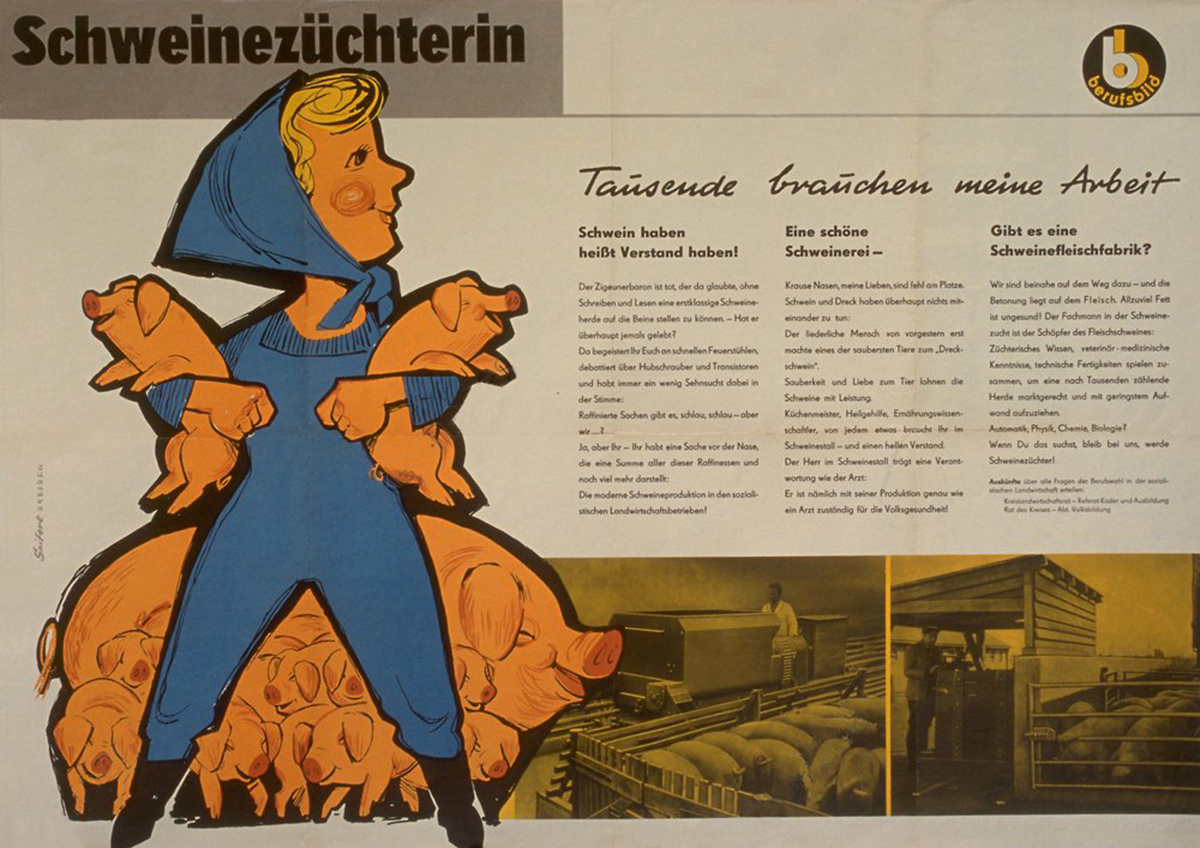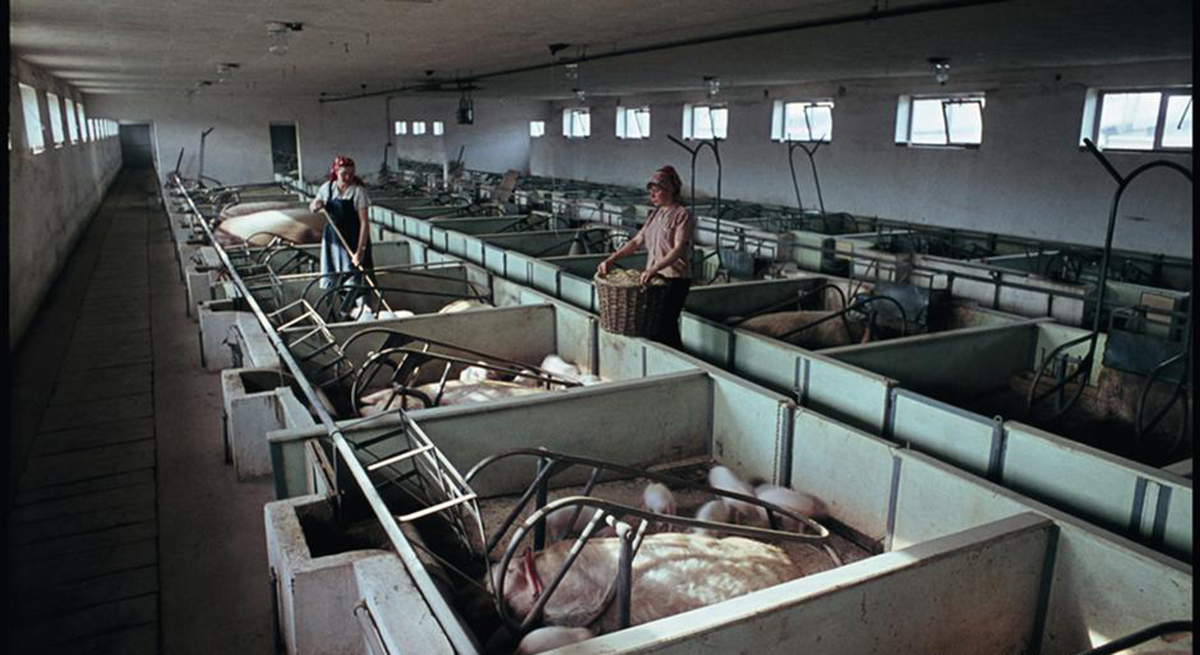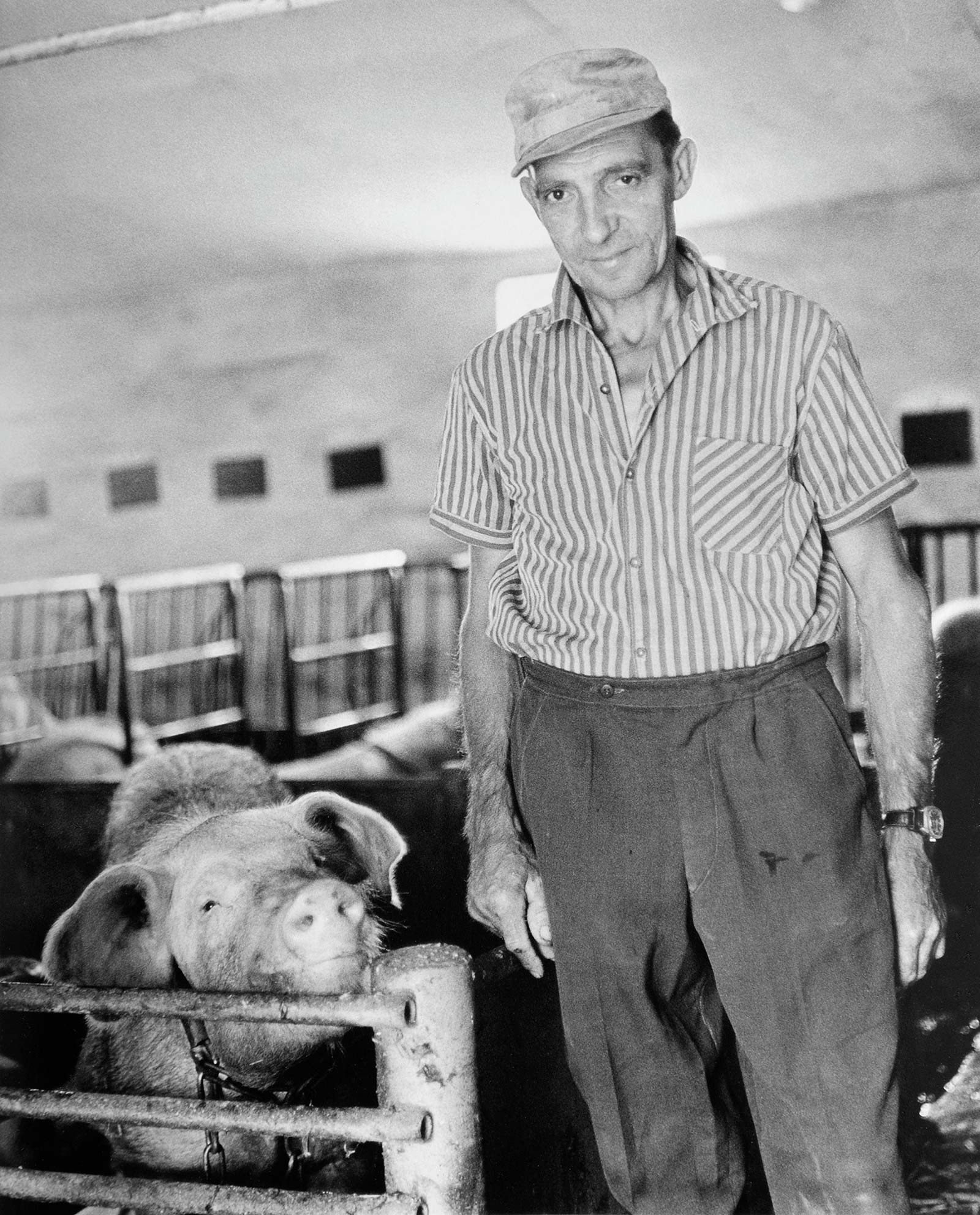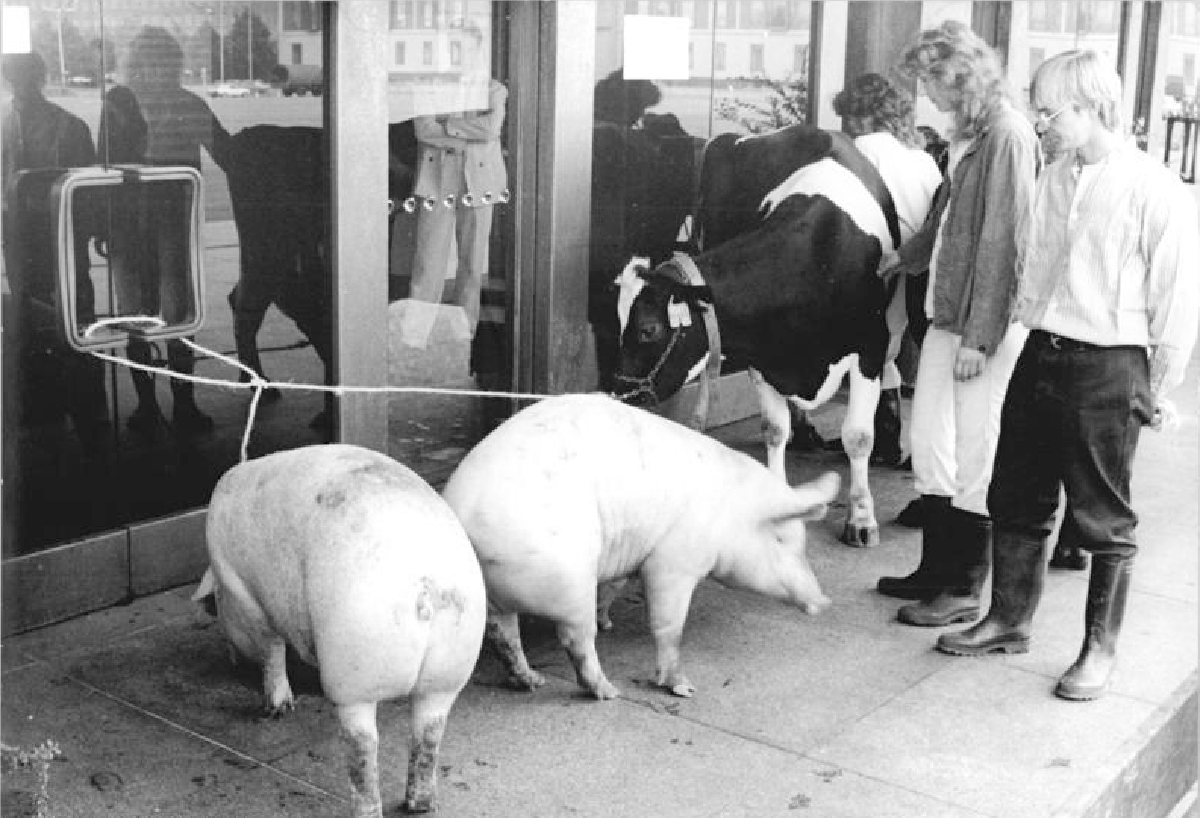Animal Farms
A porcine history of East Germany’s rise and fall
Thomas Fleischman

“It is a sort of fairy story,” George Orwell wrote to his literary agent in 1944, “really a fable with a political meaning.”[1] The fable was Animal Farm, and in it, Orwell set out to destroy the “Soviet myth” and the cult of Stalin.[2] In our time, Animal Farm has become a standard part of any school education. In August 1945, when it was published in the United Kingdom, and in April 1946 when it came out in the United States, it was political dynamite. Animal Farm drew praise for its allusions to the history of the Russian Revolution, including livestock portrayed as proletariat rebels, “Animalism” as a stand in for Marxism-Leninism, and the sketches of Lenin, Stalin, and Trotsky in the pigs Old Major, Napoleon, and Snowball. Most memorable of all was the pigs’ ultimate betrayal of the revolution, symbolized in the execution of the exploited draught-horse Boxer. Reviewing the book in the New York Times in 1946, the presidential historian Arthur Schlesinger Jr. wrote that it was “a simple story perhaps, but a story of deadly simplicity.”[3]
While Orwell’s allegory began as a “simple story,” it did not stay that way for long. For the next half century, politicians and writers co-opted Orwell’s message to justify their own vision of the ideological clash at the heart of the Cold War. Liberals praised Animal Farm, and Orwell’s later dystopian masterpiece, 1984, for breaking the European Left’s love affair with communism. By the early 1950s, Animal Farm and 1984 were being used by Dean Acheson as cultural weapons in the early Cold War. The US State Department disseminated copies all over the world, and Acheson declared that “Animal Farm and 1984 have been of great value to the US in its psychological offensive against Communism.”[4] In the hands of Cold Warriors, Orwell’s works told of a world starkly divided between dictatorships and democracies, planned economies and free markets, communists and capitalists.[5] Reflecting in 1986 on Orwell’s legacy, the American neoconservative Norman Podhoretz declared him “the patron saint of anti-Communism.”[6] This would have been news to Orwell, who remained an unrepentant socialist until his death despite his antipathy for Stalin. To read Animal Farm as simple anti-Communist satire is to miss the sting at the end. Orwell’s allegory is not about a world riven by ideological division. It instead warns about a world dominated by a new permanent ruling class, pigs and men together. The masters of the Orwellian nightmare believed in a hegemonic ideology that fused the authoritarian impulses of Stalinism with the iron hand of capitalistic coercion and exploitation. For Orwell, ideology was not something that existed solely in the communist East and was absent in the capitalist West; it ruled both.
Rather than perceiving the Cold War solely in terms of its oppositions, Orwell exhorts us to see what is shared. This is most evident in the other central drama of Animal Farm, agriculture. Napoleon’s grab for power transforms a small traditional farm into an export-oriented factory. Year after year, the farm grows in size, invests in expensive technologies, and mandates a strict division of labor between managers, technicians, and workers. By the end of the allegory, modernization has made friends out of former enemies. The famous last scene shows the “communist” pigs and the “capitalist” men celebrating together in a drunken rout, with the proletarian worker animals peeking through the window. “The creatures outside looked from pig to man, and man to pig, and from pig to man again; but already it was impossible to say which was which.”[7]
As it turns out, the animals’ observation was more than just metaphor; it became fact during the Cold War, when agriculture in the East and West moved closer and closer together. By the 1980s, communist agriculture had been drawn into global markets by the fervent adoption of factory farming, in many ways becoming indistinguishable from capitalist agriculture. And there was no better place to see Animal Farm become Factory Farm than in the German Democratic Republic (GDR).
If the word “Orwellian” is shorthand for a kind of “totalitarian” regime, then the GDR seemed to be its real-world embodiment. The GDR was also a creation of Stalin. Founded in 1949 on the ruins of the Nazi state, the GDR clearly had Orwellian aspects. There were militarized borders, the ubiquitous secret police, a top-down planned economy, and propaganda-stoked hatred of its western twin, the Federal Republic of Germany (FRG). Many contemporaries saw the GDR as a strange, reverse-engineered, mirror-image of West Germany—a real life “Animal Farm,” fundamentally flawed from the outset and, in retrospect, doomed to failure.
And when the regime collapsed in 1989, international observers and East German citizens cited the GDR’s poor environmental record, in particular air and water pollution, as a major source of the government’s de-legitimization. This view only became further entrenched in the 1990s. Der Spiegel derided the East German state in its entirety as an “ecological outlaw of the first rank.” Discussing the prospects for German reunification that same year, the New York Times saw pollution as the fault line dividing East and West, warning that “one issue taking on urgency is how the orderly and clean half of the country can help clean up the disheveled and polluted half.”[8] Some historians have advanced a similar view, reducing the forty-year history of East Germany into a tale of environmental, ideological, and economic disaster.[9] They argue that the dictatorship, by following the distorted imperatives of the planned economy and communist ideology, undermined the freedom and prosperity of its people to produce a one-of-a-kind ecological disaster.
Much like the misreading of Animal Farm, this perspective teaches us the wrong lessons. In fact, the GDR’s environmental crises were not sui generis. They became common features of industrial agriculture under both capitalism and communism. Throughout the Cold War, communist and capitalist countries adopted analogous forms of agricultural production, treating land, labor, and animals as cheap and disposable. Whether in Mecklenburg or Iowa, a similar landscape emerged: vast seas of grain and oil seed monocultures; archipelagoes of concentrated, confined livestock; assemblages of exploited, disempowered workers; watersheds of poisoned rivers and contaminated lakes.[10] Bearing this convergence in mind, the GDR’s multiple environmental crises of the 1980s—the crisis of air and water pollution, the breakdowns in its farms, and the series of temporary food shortages—appear not as an aberration, but in fact a central feature of industrial agriculture everywhere. They show that cheap food is in fact unimaginably expensive. And in the 1980s, its costs spilled over into all facets of East German life.
If Animal Farm is an allegory best told by pigs, then the environmental history of East Germany is one pigs tell really well. Taxonomically, Sus scrofa has a genus all to itself. Sus is one of several genera—the exact number is a subject of debate—in the broader family Suidae, a group that includes warthogs, peccaries, and pygmy hogs.[11] All domesticated pigs, however, descend from one elusive ancestor, the Eurasian wild boar. Pigs also possess numerous fantastic traits—omnivorous diets, high intelligence, the ability to survive as domesticates or wild animals. But the most fantastic trait of all is their physical malleability. Just consider the variety of sizes, colors, and shapes in domesticated pigs and you will understand what I mean. In fact, given the right conditions, every barnyard swine can revert to its wild form. Leave a young piglet to its own devices shortly after birth, and a series of transformations take hold—its skull and legs will grow longer, its ears will stand erect, and bristly hairs and a spiked mane will burst from the crest of its skull to its tail. In just one generation, this once-domesticated pig will appear as vicious and wild as its grandfather Sus scrofa.[12] Thus, all pigs—from the hairiest wild boar to the most “scientifically improved” factory pig—are in fact the same species. This plasticity also helps historians. We can “read” changes in pig morphology, behavior, diet, and habitat as a window into the past.

In the GDR, three pig archetypes—which I call the industrial pig, the “garden” pig, and the wild boar—reveal the surprisingly global history of East Germany. No animal, save Homo sapiens, was more central than the pig to the arc of the GDR’s existence. Already in the first two decades of postwar reconstruction—roughly 1949 to 1969—it had come to occupy a fundamental position in the regime’s uneven, halting attempts to create a modern industrial food system. Planners remade collective farms to promote grain monocultures and animal confinement. They went abroad seeking technology and expertise in vertically integrated hog production, even importing live pigs to alter the genetic makeup of their hogs. Throughout this period, planners in East Germany measured economic progress in heads of hog, and sold that message to its citizens (and Western skeptics) in kilograms of pork. By the end of the 1960s, agriculture had advanced and production levels exceeded those of the pre-war period. The GDR’s numbers, however, still lagged behind production in the West. Chronic problems—supply chain bottlenecks, sudden shortages, and missed quotas—persisted. Expensive machinery, agrochemicals, and massive state investment had failed to boost production to a level that could support meat exports while simultaneously feeding the people. According to the GDR’s own metrics, Sus scrofa didn’t measure up.
Then the “rules” of the Cold War changed. In the 1970s, four major events destabilized the postwar economic and political order, remaking global capitalism and, with it, the relationship of the GDR to the West: the end of the Bretton Woods agreement in 1971; the Russian grain deal of 1972 (which has been called the “Great Grain Robbery”); the Basic Treaty between the FRG and the GDR in 1972; and the Oil Crisis of 1973. For a short period in the mid-1970s, the rate of inflation well exceeded interest rates on short-term loans—in effect making borrowed money almost free.[13] Taken together, these events produced a realignment in the conditions of global capitalism, which rebounded to the benefit of East Germany and Sus scrofa.[14]
Suddenly planners had access to Western markets, and a world of “cheap things” poured into the GDR and down the gaping maws of millions of industrial pigs.[15] From the perspective of East German planners, as well as international observers, this boosted the country’s gross national product. Cheap Western grain alleviated production pressure on East Germany’s collective grain and hog farmers while boosting domestic pork production. The pig population rose from 9 million in 1972 to over 12 million by the early 1980s. Cheap capital, gained through Western loans and Soviet oil, allowed the GDR to import more Western technology, which increased production; it underwrote an expansion of mega-livestock-complexes for hogs, but also for poultry and cattle.[16] Under these new conditions of world trade, the regime believed its agricultural sector would export enough pork products to gain a market share in the West. By the 1980s, East Germany’s hog farms resembled those in the Iowa countryside, and appeared as familiar to any American agribusinessman from Hormel or Iowa Beef Processors. The turn toward the West saved the industrial pig in East Germany, and boosted the country into the top ranks of world economies. It also planted the seeds of an ecological crisis that would destabilize the country a decade later.

If the 1970s were the decade of cheap grain and capital, the 1980s were the decade of rising costs. By 1981, the East German regime found itself trapped between the demands of its citizens and world markets. To the east, the Soviet Union announced steep cuts in deliveries of the GDR’s most reliable export, Soviet oil, while to the west, creditors called in their loans as interest rates climbed and a global recession set in. The factory farms struggled to satisfy domestic demand and simultaneously increase exports. The regime faced a dilemma—should it extricate the GDR from Western markets by cutting grain imports and scale back pork exports? Or should they continue to service their debts and fulfill their contracts (following the so-called “Iron Law of Exports”)? Again and again, the regime chose to prioritize the latter. This turn toward the West not only caused the expansion of East German industrial agriculture, but also accelerated the environmental crisis, driving the factory farm system to the breaking point as it struggled to satisfy Western creditors.
The turn was not just critical to the economic and political situation; it also induced transformations in Sus scrofa. It was in this decade that the three pigs became most clearly differentiated and visible in the everyday life. Some pigs, once thought relics of the past, increased in number. “Garden” pigs, or pigs raised by individual collective farmers, returned to small plots and allotment farms in the countryside, opening a porcine-shaped loophole in the regime’s hostility toward these so-called “remnants” of “bourgeois” capitalism. Acting as a kind of star species of subsistence farming and animal breeding, the garden pig occupied the marginal spaces on the periphery of the planned economy. These ranged from small individual plots on collective farms, where garden pigs reigned, to backyard gardens and exurban garden colonies, where people grew fruit and vegetables, planted flowers, kept bees, and raised small animals such as rabbits and chickens.[17] In the decade in which industrial agriculture foundered under the demands of economic planners, rampant pollution, and volatile financial markets, small-scale production became central to the survival of the entire food system. Not only did garden pigs, and thus garden farmers, prove their worth; they also allowed everyday East Germans to expand the definition of “real, existing socialism” beyond a guaranteed, basic quality of life. Under socialism, everyday East Germans came to believe they also had a right to rest, recreate, or work, in a green space of one’s own.
At the same time, wild boars, a folkloric symbol of German Nature, suddenly appeared in suburban developments, collective farm fields, and state forests, becoming a public nuisance. As the GDR industrialized its farms in the 1970s, the wild boar population exploded. Larger fields, simplified rotations, and a paradoxical expansion in forest cover, created ideal “edge space” habitat for wild boars to eat, migrate, hide, and breed. Wild boars showed how some pigs were able to take advantage of an environment remade for industrial agriculture, raising questions for East Germans about who and what exactly belonged in a healthy, socialist natural world.
By the mid-1980s, there was no place in the country untouched by pigs. As industrial pigs grew fatter and more numerous, but also less healthy and more destructive to the environment, East Germans noticed the results in the supermarkets, as well as the environment. Hikers who went into the woods to commune with nature found themselves facing not only marauding wild boars, but mountains of toxic industrial pig manure trucked from overflowing sewage lagoons on massive collective pig farms.
The East German regime pursued industrial pork production to realize the project of “real, existing socialism,” only to see those same pigs advance the global conquest of industrial agriculture in the GDR, remaking the country’s environment, economy, and government in the image of the rest of the world. As the economic and environmental costs continued to rise, the regime refused to change course, preferring to squeeze every last kilo of pork out of the system to satisfy their creditors. The environmental crisis eventually became a political one, bringing the regime close to collapse once in 1982, and then permanent dissolution in 1989.

We are not yet free of East Germany’s ecological legacy, which tells us about the recent past and the warming world to come. The global pandemic is only the latest ecological crisis to reveal the ways in which the world has been remade to suit the production of industrial meat. From the US to Germany, slaughterhouses—where low-wage, primarily immigrant laborers work in close quarters, producing meat for global export—have seeded massive coronavirus outbreaks. While some factories, like Germany’s largest meat-packer Tönnies, shut down, most did not. Instead, companies like Smithfield and Tyson Foods—two of the largest producers in the US—warned of massive meat shortages, yet all the while exporting record amounts of meat abroad.[18] This is an eerie echo of East Germany’s own pork crisis in 1982, when several epizootic outbreaks brought the regime to the edge of insolvency. Cascading shortfalls in production upended supply chains and left swaths of the country with little meat in the spring and summer. While East Germans queued in long lines for their roasts and sausages, they also complained bitterly that the regime continued to prioritize meat exports abroad, even as their own citizens grew more irate. The same industrial system that arose in the GDR continues to churn in every corner of the globe. It remains capable of producing unprecedented amounts of meat, but also pollution, sickness, and ecological disaster. In the era of climate change, environmental disruptions will only intensify, and as they do, the system of industrial meat will become more and more precarious. Before too long, it will break. It’s a lesson that East Germans learned a generation ago. And it’s one we should heed closely.
• • •
In Animal Farm, the seven revolutionary commandments are painted on the side of the barn so all the animals can learn them. The seventh commandment—and the most important—is, “All animals are equal.” Eventually the ruling Stalinist pigs amend the seventh commandment to read: “All animals are equal but some animals are more equal than others.” With apologies to Orwell, East Germany’s pigs are more than equal to the task of connecting the history of the GDR to the environmental history of the world in the twentieth century. They reveal the quixotic project of cheap food and its high costs. It’s a story much greater than the size and even lifespan of the GDR. It is nested in different layers of history: of Germany, of communism, of the Cold War, but also of the United States, of development, of capitalism, and animals—especially pigs.
The industrial pig, garden pig, and wild boar lead us through the rise and fall of East German industrial agriculture but also foreshadow changes around the world where such large-scale schemes are imposed without regard for people, animals, or environments. In East Germany’s collapse, they point to an underappreciated source of the regime’s political instability. Indeed, should the polluted, hot world of capitalist nature come to an abrupt end, between people and pigs, Sus scrofa might prove to be the more equal animal.
This essay is adapted from Thomas Fleischman’s recently published book Communist Pigs: An Animal History of East Germany’s Rise and Fall (University of Washington Press, 2020).
- George Orwell, A Life in Letters, ed. Peter Davison (New York: Liveright Publishing Corporation, 2013), p. 229.
- Ibid.
- Arthur Schlesinger, “Mr. Orwell and the Communists,” The New York Times, 25 August 1946.
- Dean Acheson, “Participation of Books in Department’s Fight against Communism,” US State Department memorandum, 11 April 1951. Cited in Understanding Animal Farm: A Student Casebook to Issues, Sources, and Historical Documents, ed. John Rodden (Westport, CT: Greenwood Publishing Group, 1999), p. 146.
- Frances Stonor Saunders, The Cultural Cold War: The CIA and the World of Arts and Letters (New York: The New Press, 2013), pp. 247–248, and Adam Gopnik, “Honest, Decent, Wrong: The Invention of George Orwell,” The New Yorker, 27 January 2003; available at www.newyorker.com/magazine/2003/01/27/honest-decent-wrong. Animal Farm wasn’t just reinterpreted by the US government; it actually changed the ending. In 1951, the CIA purchased rights to the film, a transaction that future Watergate burglar and early Cold War CIA operative E. Howard Hunt claimed, perhaps apocryphally, had been completed after Orwell’s widow, Sonia, was promised an in-person introduction to Clark Gable. After CIA-hired psychologists scrutinized an early draft of the script, remarking that “there is no great clarity of message,” the agency arranged that the subsequent animated film, made in the UK in the 1950s, omit Orwell’s explicit characterization of despotic pigs as identical with their erstwhile capitalist enemies. Instead, the cartoon depicts the other livestock storming the farmhouse Bastille of the pigs, to begin the animal revolution all over again.
- Interview with Norman Podhoretz. Cited in Understanding Animal Farm, ed. John Rodden, p. 142.
- George Orwell, Animal Farm (New York: Harcourt, 1954), p. 155.
- Raymond Dominick, “Capitalism, Communism, and Environmental Protection: Lessons from the German Experience,” Environmental History, vol. 3, issue 3 (July 1998), p. 311.
- Arvid Nelson, Cold War Ecology: Forests, Farms, and People in the East German Landscape, 1945–1989 (New Haven, CT: Yale University Press, 2005).
- Tony Weis, The Ecological Hoofprint: The Global Burden of Industrial Livestock (London: Zed Books, 2013).
- Brett Mizelle, Pig (London: Reaktion Books, 2011).
- Lyall Watson, The Whole Hog: Exploring the Extraordinary Potential of Pigs (Washington, DC: Smithsonian Books, 2004), p. 108.
- Gareth Dale, Between State Capitalism and Globalisation: The Collapse of the East German Economy (Oxford: Peter Lang, 2004), p. 195.
- Stephen Kotkin, “The Kiss of Debt: The East Bloc Goes Borrowing,” in The Shock of the Global: The 1970s in Perspective, ed. Niall Ferguson et al. (Cambridge, MA: Belknap Press of Harvard University Press, 2010).
- See Jason W. Moore, Capitalism in the Web of Life: Ecology and the Accumulation of Capital (London: Verso, 2015); Raj Patel and Jason W. Moore, A History of the World in Seven Cheap Things: A Guide to Capitalism, Nature, and the Future of the Planet (Oakland: University of California Press, 2017); and Raj Patel, “The Long Green Revolution” Journal of Peasant Studies, vol. 40, no. 1 (2013). Moore and Patel’s theory, which provides the central analytical framework of my book Communist Pigs: An Animal History of East Germany’s Rise and Fall, is one to which I return repeatedly. Their work argues that capitalism is a way of organizing nature into “cheap” things. Over the past five hundred years, it has constantly remade planetary nature to suit the expansion and accumulation of capital. Their “capitalism-as-world-ecology” theory argues that the separation of nature and culture was foundational to the emergence of capitalism as a historical force. This separation created the category of so-called “Free Gifts” from Nature, which Moore and Patel identify as food, energy, work, care, money, raw materials, and lives, and which were extracted from the “frontiers” of capitalist expansion. These “frontiers,” however, were not merely spatial. They were also biophysical, material, and social. Since the late fifteenth century, capitalism has extracted cheap nature from a variety of “frontiers”—not only colonies, but also bodies (slaves and women’s reproduction), the subterranean world (coal and crude oil), and the atmosphere (synthetic nitrogen).
- Patrice G. Poutrus, Die Erfindung des Goldbroilers: Über den Zusammenhang zwischen Herrschaftssicherung und Konsumentwicklung in der DDR (Cologne: Böhlau, 2002).
- The charter of each collective farm guaranteed a general use-right of land for all members, granting each farmer a half-hectare of land (about one and a quarter acres) for private production. These charters permitted each member to raise up to two cows, two sows and their offspring, five sheep, and as many other small animals (chickens, geese, rabbits, goats) as they desired.
- Michael Corkery and David Yaffe-Bellany, “U.S. Food Supply Chain Is Strained as Virus Spreads” The New York Times, 13 April 2020; available at www.nytimes.com/2020/04/13/business/coronavirus-food-supply.html. Corkery and Yaffe-Bellany, “As Meat Plants Stayed Open to Feed Americans, Exports to China Surged,” The New York Times, 16 June 2020; available at www.nytimes.com/2020/06/16/business/meat-industry-china-pork.html.
Thomas Fleischman is an assistant professor of history at the University of Rochester. He is the author of Communist Pigs: An Animal History of East Germany’s Rise and Fall (University of Washington Press, 2020).
Spotted an error? Email us at corrections at cabinetmagazine dot org.
If you’ve enjoyed the free articles that we offer on our site, please consider subscribing to our nonprofit magazine. You get twelve online issues and unlimited access to all our archives.